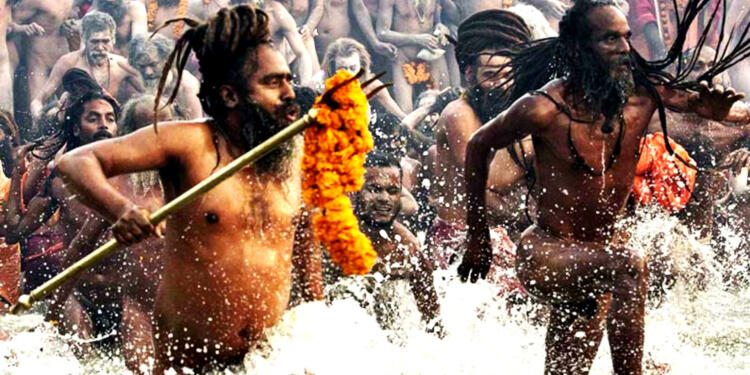- Naga Sadhus had defended Kashi Vishwanath Mandir from onslaughts of Aurangzeb
- More than 40,000 Sadhus laid their lives while fighting against lakhs of Mughals for protecting the Dharma
- Most of the history books do not mention the ‘Battle of Gyanvapi’ in their description
Naga Sadhus are one of the most mysterious categories of Sadhus for modern generations. Matted dreadlocks and Trishuls are two trademarks of them. Very few people know that these Trishuls were the main weapons used to defend Kashi Vishwanath Mandir from Aurangzeb.
Nagas were fed up with Muslims
Nagas were not known for caring until Mughals came for their fellow Sadhus. The Naga Sadhus were reorganized in the 16th century by Madhusudan Saraswati of Bengal. Madhusudan Saraswati was a philosopher of the Advaita Vedanta tradition and a contemporary of Akbar.
After being fed up with Muslims attacking Sadhus without any reason, Madhusudan Saraswati tried to talk with Akbar. But Akbar did not respond to his requests. He reorganized the Naga Sadhus and initiated action to protect the Hindus from the atrocities committed on them by the Muslims.
Read more: Dhruv Rathee insults Naga Sadhus, calls them ‘unemployed people’
Historical evidence
William R. Pinch describes its historical basis in his book Soldier Monks and Militant Monks. Despite the debate over whether this theory is true, there is evidence that after Madhusudan returned from Agra, the Naga sadhus gathered in Varanasi and took an oath to protect the Hindus.
Baba Rampuri in his book Autobiography of a Sadhu: A Journey in Mystic India gives a detailed account of the Naga Sadhus and their Akharas. Rampuri, an American born as William A. Gans, after learning the truth from Indian philosophy and culture, is the first Westerner to become a Naga Sadhu. Presently he is Shri Mahant in Shri Panch Dasnam Juna Akhara.
Battle of Gyanvapi
Aurangzeb and his Mughal army again attacked the Kashi Vishwanath Mandir in 1664. Then, the Naga Sadhus got fed up and opposed it for the first time and defended the temple. They badly defeated Aurangzeb and his army. This defeat of the Mughals was mentioned in James G. Lochtefeld’s book The Illustrated Encyclopedia of Hinduism.
He described this event in his book as the ‘Battle of Gyanvapi‘. Note that the victory of the Naga Sadhus against Aurangzeb and his army is called ‘Great’ in this description. Even though this war is not properly described, you can imagine how the Naga Sadhus wreaked havoc on the huge and armed Mughal army that they did not dare to look at Kashi for 4 years.
Lochtefeld writes, “The battle was reportedly fought in Banaras by the Naga ascetic warriors of the Mahanirvani Akhara. According to a handwritten book in the archives of the Akhara, the soldiers of the Akhara won a major victory near the Gyanvapi well in 1664.” This document only states that the ascetics were victorious against the forces of the “sultan”, although historians have speculated that the figure was the Mughal emperor Aurangzeb.
Read more: Yogi govt is removing every mark left by Aurangzeb’s tyranny and Gyanvapi Mosque is the next target
Future generations need to know this
According to local folklore and oral tales, around 40,000 Naga sadhus laid down their lives while protecting the Kashi Vishwanath Jyotirlinga. Their valour can be gauged from the fact that they were fighting the Mughal army counting in lakhs.
The thrashing of Aurangzeb by Naga Sadhus was so brutal that it took a long time for them to regroup. The irony is that our own Indian Historians did not find this valour worthy enough to be mentioned in our history books.
